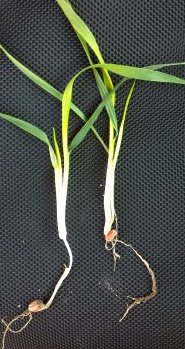Evaluating seedling wheat stands this fall
Before snow blankets the fields, evaluating wheat fields may be helpful.

Much of wheat’s yield potential is determined by how early and uniformly the seedlings emerge. Michigan State University Extension suggests noting the differences within and between fields may help fine-tune your planting practices.
Uniform emergence
Environmental conditions, such as dry weather, can make it particularly challenging to have all seedlings emerge relatively uniformly. Particularly where the seed is broadcasted over soybeans or sown in dry soils, some fields can exhibit a significant delay in seed and seedling development until the rain finally arrives. In most cases, enough viable seed can still produce reasonably good stands, but emergence in these fields may occur over a couple of weeks. This means that seedlings can be at different developmental stages throughout the season and may have implications for the application timing of future herbicides, growth regulators and fungicides.
Uniform plant densities
Gaps and uneven growth within a stand should be noted, as well as any apparent causes such as crop residue, traffic, or drill performance so that corrective action can be taken before next fall. Also, one should make a note of unhealthy pockets of seedlings and attempt to diagnose the problem. If the roots appear discolored and diseases are suspected, mail seedling samples to MSU Plant & Pest Diagnostics (cost covered by the Michigan Wheat Program).
Submitting soil samples to a soil analysis laboratory could also be helpful (collect soil from both the poor area and from an adjacent good area to aid in diagnosis).
Seedling population
It is worthwhile to determine the number of seedlings per foot of row—this exercise is much easier if performed prior to extensive tillering. Generally, early planted wheat would have 14 to 20 plants per foot of row (7.5-inch row spacing), whereas you might aim for 22 or more seedlings where sown in mid-October.
Knowing the number of seedlings per foot of row is useful in determining how closely it aligns with the intended seeding rate and drill setting. The table below can serve as a reference. For example, if you feel you were dropping 1.8 million seeds per acre (26 seeds per foot of row), but find an average of less than 20 seedlings per foot, it would be worthwhile to determine the reason. In some cases, it might be due to an over-estimation of seeding rate. In other situations, it may be associated with difficulties in germination or emergence.
|
Relating target seeding rate per acre to seed and seedling numbers (for 7.5-inch row spacing). |
||
|---|---|---|
|
Seeding rate (millions/ac) |
Seeds per foot of row* |
Seedlings per foot of row** |
|
1.2 |
17.2 |
16.2 (94%) |
|
1.4 |
20.1 |
18.5 (92%) |
|
1.6 |
23.0 |
20.7 (90%) |
|
1.8 |
25.8 |
22.7 (88%) |
|
2.0 |
28.7 |
24.7 (86%) |
|
2.2 |
31.6 |
26.5 (84%) |
* Target seeding rate/43,560 x 0.625 = seeds per foot of row (7.5-inch spacing).
** Projected number of seedlings based on an estimated declining emergence rate (shown as percent within parentheses).
Seeding depth
Confirming actual seed depth placement can also be worthwhile. The actual depth can be determined by simply digging up the seed or measuring the distance between the seed and the crown. Where the seed is next to the crown, you can surmise that the seed was placed a half-inch or less below ground. Where a mesocotyl is visible between the seed and crown, its length plus another half-inch approximates the seed’s original depth (see photo below).

Development
Generally, the goal is to have wheat planted early enough so there is sufficient warm weather for the main shoots to develop a couple of tillers. This stage of growth suggests the plant has a well-developed root and shoot system for winter survival and for taking full advantage of the next spring’s growing environment.
Weeds
Note any weeds that have emerged, particularly winter annuals that emerge this fall. Refer to "Weed control in winter wheat: What do I need to consider?" by MSU's Christy Sprague for more information on developing a herbicide strategy. Also, the annually updated Weed Control Guide is a very helpful reference. If there is adequate fall wheat growth, consider a fall-applied herbicide, especially if red clover will be used as a cover crop.
Office work
Obviously, these evaluations are most constructive if you create a record for each field. This record would at least include variety, seed size and drill settings. Martin Nagelkirk created a form for you to download and print to take seedling and evaluation notes.
Download Form for Evaluating Seeding Operation and Seedling Stands
It is also a good idea to save seed tags that include lot numbers and seed characteristics. To remain compliant, report your fall-planted small grain acreage to the Farm Service Agency by the established deadline. Lastly, consider options and requirements for purchasing crop insurance.



 Print
Print Email
Email